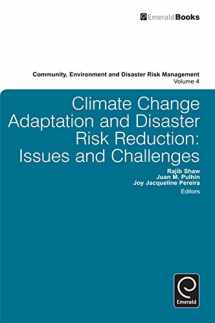
Climate Change Adaptation and Disaster Risk Reduction: Issues and Challenges (Community, Environment and Disaster Risk Management, 4)
ISBN-13:
9780857244871
ISBN-10:
0857244876
Edition:
Illustrated
Author:
Juan M. Pulhin, Rajib Shaw, Joy Jacqueline Pereira
Publication date:
2010
Publisher:
Emerald Publishing Limited
Format:
Hardcover
416 pages
Category:
Climatology
,
Earth Sciences
,
Rivers
,
Nature & Ecology
,
Conservation
FREE US shipping
Book details
ISBN-13:
9780857244871
ISBN-10:
0857244876
Edition:
Illustrated
Author:
Juan M. Pulhin, Rajib Shaw, Joy Jacqueline Pereira
Publication date:
2010
Publisher:
Emerald Publishing Limited
Format:
Hardcover
416 pages
Category:
Climatology
,
Earth Sciences
,
Rivers
,
Nature & Ecology
,
Conservation
Summary
Climate Change Adaptation and Disaster Risk Reduction: Issues and Challenges (Community, Environment and Disaster Risk Management, 4) (ISBN-13: 9780857244871 and ISBN-10: 0857244876), written by authors
Juan M. Pulhin, Rajib Shaw, Joy Jacqueline Pereira, was published by Emerald Publishing Limited in 2010.
With an overall rating of 4.0 stars, it's a notable title among other
Climatology
(Earth Sciences, Rivers, Nature & Ecology, Conservation) books. You can easily purchase or rent Climate Change Adaptation and Disaster Risk Reduction: Issues and Challenges (Community, Environment and Disaster Risk Management, 4) (Hardcover) from BooksRun,
along with many other new and used
Climatology
books
and textbooks.
And, if you're looking to sell your copy, our current buyback offer is $0.3.
Description
The importance of Climate Change Adaptation (CCA) and Disaster Risk Reduction (DRR) is increasing due, in part, to recent major disasters throughout the world. CCA and DRR are closely associated and there has been significant awareness at global and national levels to make collective focus on CCA and DRR. Although there are several books on CCA, this is the first systematic academic publication to highlight the linkages between CCA and DRR, CCA-DRR synergy and interactions. The book is divided into four parts: Part 1 focuses on the theory of CCA and DRR and its enabling environment; Part 2 focuses on governance, education and technology as the framework of CCA-DRR linkage; Part 3 focuses on different entry points with chapters on urban, coast, mountain, river and housing; and Part 4 focuses on regional perspective of CCA and DRR looking at developing nations, south Asia, ASEAN and Small Island Developing States. Key issues and challenges related to the CCA and DRR are highlighted throughout, mostly drawing lessons and experiences from the field practices. This book gives researchers and practitioners greater awareness on the current trend of research in the field.


We would LOVE it if you could help us and other readers by reviewing the book
Book review

Congratulations! We have received your book review.
{user}
{createdAt}
by {truncated_author}


